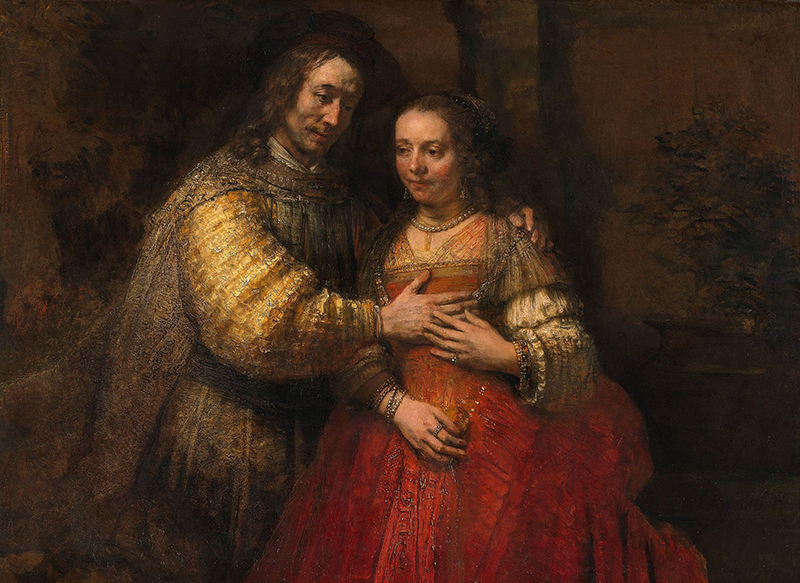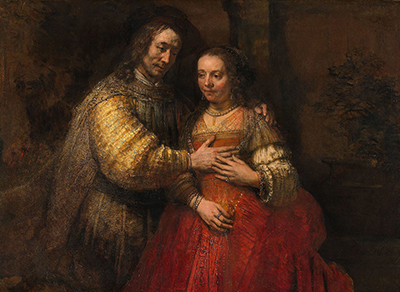Rembrandt painted The Jewish Bride in 1667, late in his career. It was for a long time thought to show a Jewish father giving his daughter a necklace on her wedding day, but art historians now think this is incorrect.
Some have suggested that the painting shows Rembrandt's son Titus and his wife, others that it shows an Old Testament scene, or a contemporary couple in a portrait historié - a fancy-dress portrait.
What appears certain is that the painting is about a couple in love, not a father and daughter, and it's probable that the painting shows Isaac and Rebekah, another Old Testament story. Rembrandt loved painting Biblical themes, so this would not be an unusual choice of subject for him.
Rembrandt lavishes his care on the details of the couple's rich clothing and accessories. The woman's pearl necklace, rings, and bracelets are beautifully painted, the pearls fat and glowing, and there are glints of light from the silk of her skirts.
Meanwhile Rembrandt has laid on massively thick coats of paint to show the rich texture of her husband's clothes, painting with a palette knife instead of a brush - revolutionary at this period.
The use of brilliant colours - crimson, gold, bright whites and hints of green - is typical of his later style, and he throws these colours into prominence by giving the painting a sombre, shadowy background.
In all the details of its brushwork and colouring, the painting shows that Rembrandt was truly a master of his craft by now, and continuing to push the boundaries and to try new things.
It's a painting that shows great tenderness, but there is something ceremonious and perhaps a little melancholy about this relationship; this isn't a seduction scene of the kind that was so popular with Dutch art buyers in Rembrandt's time. The couple seem to avoid eye contact, as if they both have secret thoughts that they are unwilling to share; there is a feeling of intimacy, but also constraint.
The husband's eyes are hooded, and his expression is sad, while the wife's smile seems uncertain. Husband and wife stand against a sombre background, and the love story seems to be threatened by a cloudy future. (If this is indeed a painting of Isaac and Rebekah, that may reflect the fact that Isaac kept their love secret, pretending that Rebekah was his sister, for fear the king Abimelech would fall in love with her and have Isaac killed.)
Three hands make an almost triangular focus at the centre of the painting; the woman caresses her husband's hand over her breast, while her other hand holds her stomach (perhaps suggesting a child on the way). The hands are in bright light compared to the couple's faces; they may not make eye contact, but their hands tel the story of their love in a far more intimate way that a look ever could. (The husband's other hand is more difficult to spot - resting gently on his wife's shoulder.)
This is surely one of Rembrandt's greatest portrait paintings, a masterpiece of subdued emotion and fluent painting. Van Gogh said he would give ten years of his life just to be able to sit and look at this picture for a fortnight, "with nothing to eat but dry bread".





